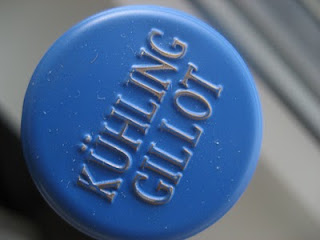
As cross-breed grape varietals go, Scheurebe (roughly pronounced
shoy-rey-ber) is probably my favourite. The first ever Scheurebe I drank was back in 1997: an Auslese from Reichsrat von Buhl (the vineyard was "Ruppertsberger Reiterpfad") and a pyschedelic explosion of blackcurrant, grapefruit and lychee if there ever was one. At its best, Scheu also has a refreshing level of acidity.
Without exception, all the Scheurebe I'd had until now contained residual sugar to differing degrees. For one thing, they certainly weren't
trocken. And yet dry Scheu is all the rage these days among Germany's
trocken-conscious clientele. So, what better intoduction to Scheu
trocken than a wine from a reputable vineyard in Rheinhessen, Germany's Scheu hotbed (along with the Pfalz).
Weingut Kühling-Gillot, Qvinterra Scheurebe trocken 2008, RheinhessenThe name "Qvinterra" refers to the fact that the fruit for this wine came from five different villages along Rheinhessen's famed left bank of the Rhine: Oppenheim, Nierstein, Nackenheim, Bodenheim and Laubenheim.
Initially, this Scheu was hard to warm to: from its grey/straw-yellow appearance to its rather "stemmy", weedy aromatics and smoky palate. A totally different animal from the slightly sweeter Scheus to which I've become accustomed.
Leaving the bottle in the fridge for a day helped to change this first impression to a certain extent. Twenty-four hours later, the wine still showed a certain greenness on the nose but had also developed more flowery characteristics. According to the rather rudimentary notes I made, the palate was "juicy, clean, crisp though not overly complex", with more smoky aromas and little in the way of fruit. The finish was short and, strangely, with very little cleansing acidity.
Although this isn't the last dry Scheurebe I'll be tasting, this, frankly, was not my cup of tea. I can't help thinking that, with a bit more residual sugar, the aromatics in this Scheu would have come more to life and made for a more interesting wine.
(**Double-barrel name alert**) Now, I'll save you the spiel about Carolin Spanier-Gillot, who runs Weingut Kühling-Gillot, being married to Hans-Oliver Spanier, who runs Weingut Battenfeld-Spanier. Suffice to say that I will be covering one of Hans-Oliver's wines in my next post.
